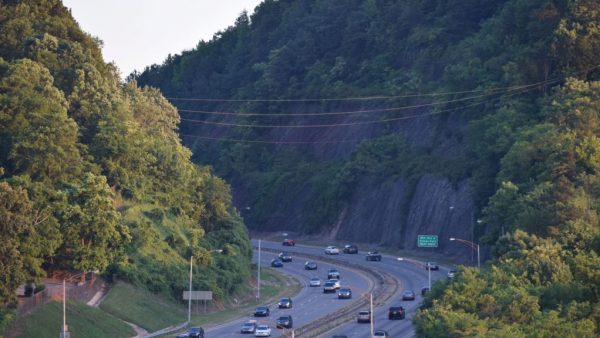Despite Pledges, Birmingham Barely Out of Gate on Energy Efficiency, Renewables, Sustainability
U.S. 280 is one of the main highways in Birmingham, cutting from down-town to the ever-expanding southern suburbs. Providing mass transit down the corridor to reduce emissions has been debated for more than 20 years, but no solution has been implemented.
By Sam Prickett
Birmingham Mayor Randall Woodfin promised in December to pivot toward prioritizing sustainability during the remaining two years of his term in office, moving toward fulfilling a pledge he made during his 2017 campaign.
“We’ve got a whole lot more environmental justice and sustainability issues to address within the next two years,” he said, “but we’ve laid the groundwork and foundation to address these environmental issues in our city.”
But for some, Woodfin’s administration — and Birmingham’s municipal government as a whole — has been frustratingly inert when it comes to environmental issues.
“The bottom line is, the city doesn’t have a strategy for addressing sustainability or environmental justice or climate change or anything related to those issues,” said Michael Hansen, executive director of Gasp, a Birmingham-based nonprofit focused on environmental justice advocacy. “The mayor campaigned on all of those issues, and several of the councilors talk about them from the daïs, but they don’t ever actually do anything about them.”
Birmingham’s lack of a clear sustainability plan has placed the city at a disadvantage compared to other cities nationwide. The American Council for an Energy Efficient Economy’s 2019 city clean energy scorecard, for instance, ranked Birmingham as 72nd among 75 major cities in terms of sustainability efforts, saying the city “has substantial room to improve across the board” and should push toward codifying goals for clean and renewable energy “to jump-start its efforts.”
“From a national perspective, energy efficiency and sustainability is a really big deal,” said Daniel Tait, chief operating officer of Energy Alabama, a sustainability advocacy group. “There’s been an explosion of cities taking on clean energy projects or climate targets everywhere across the country, including the South. In Alabama, we hardly have any of that.”
The absence of such a plan in Birmingham also has a concrete impact on residents, particularly low-income and minority households, which can face disproportionate energy cost burdens. A 2016 ACEEE study showed that Birmingham had the second-highest energy burden among 48 of the largest U.S. metropolitan statistical areas, second only to Memphis, Tennessee.
“That means that Birmingham residents pay (more) in energy as a percentage of their income,” Tait said. “Residents are bearing this burden, literally paying every month through their energy bills for the inaction of their city, for the inaction of their local leaders.”
For its part, Woodfin’s administration has maintained that a sustainability strategy is in development, though the details of that process have not been made public.
“At present, the city is examining different methods to proceed with the sustainability plan,” said Rick Journey, Woodfin’s director of communications. He said requests for proposals were sent out in 2018 “to consultants capable of developing a comprehensive sustainability plan.”
The average cost to develop a sustainability plan, Journey said, is $250,000, meaning that “a concurrent program was needed to identify funds through available grants, foundations and corporate donors to fund this effort.”
Plans for Change
After Woodfin’s election in November 2017, he established a series of citizen-led transition committees to research and make recommendations regarding a number of pressing topics. Environmental issues were placed under the purview of the social justice committee, which included an environmental justice and sustainability subcommittee.
“Cities and metropolitan hubs like Birmingham must lead the way in confronting the threat of climate change,” the subcommittee wrote in its report. “Accordingly, ensuring all municipal buildings are energy efficient is a crucial first step to the city’s commitment to begin transitioning to 100 percent renewable energy by 2027 and achieving a full transition by 2035.”
The subcommittee’s purview included a range of topics, such as sustainable food systems, park maintenance, Brownfields, pollution and waste mitigation. Among its recommendations were the creation of an office of sustainability at City Hall “with multiple staff members committed to these efforts,” the adoption of and commitment to sustainable construction policies, and the creation of a Property Accessed Clean Energy program, which would allow owners of commercial properties to finance the up-front costs of energy improvements on their property through the city and then gradually pay that cost back.
But of that committee’s recommended “short-term, low level initiatives” for implementing renewable energy practices in the city, which the subcommittee estimated could be accomplished in a timeframe of six months to two years, Woodfin has fulfilled only one. In March 2018, he signed Gasp’s “Alabama Mayors for 100% Sustainable Energy Pledge,” a largely symbolic document promising that he would “work towards” that goal during his tenure as mayor. The document did not establish a timeline or any specific strategies for reaching that goal.
“We are thankful that Mayor Woodfin is not only affirming that he believes the science behind climate change, but also that he is committed to taking action to ensure a just and equitable transition away from a fossil-fuel economy that disproportionately harms the poor and communities of color,” Gasp’s Hansen said then.
Now, nearly two years later, Hansen said it’s clear that sustainability “is not a priority,” for Woodfin’s administration.
“If the city wanted to have a sustainability plan, a real one that was actionable and progressive, then they would do it,” he said. “They have the power to do it… (But) it’s just M.I.A.”
For the most part, climate issues have been incidental to Woodfin’s priorities in his first two years in office. He has largely focused on his stated primary goal of “neighborhood revitalization” — addressing quality-of-life issues for residents such as urban blight, damaged roads and the city’s high rate of violent crime.
“During the first two years of the administration, there was an intense focus on developing an inventory of the existing issues for city operations and how the provision of services to the residents of the city could be improved upon,” Journey said. “Ensuring that basic services such as public safety, public works, blight removal, transportation and economic development were enhanced and maintained were key issues, as well as sustainability.”

Sam Prickett, BirminghamWatch
Interest groups in Birmingham have promoted alternative modes of transportation, such as sharing rides, walking or biking.
This story was written as part of a collaboration among InsideClimate News and nine media outlets in the Southeast.
Initiatives in these areas have sometimes indirectly pushed the direction of sustainability, such as the implementation of a bicycle- and pedestrian-friendly “Complete Streets” policy.
More directly, Journey said, has been the city’s “adoption of improved guidelines as it relates to stormwater and natural hazards.” In March, the Birmingham City Council approved a “post-construction stormwater ordinance” intended to minimize pollution from public and private land development by limiting construction of impermeable pavement and requiring new developments to include stormwater detention areas.
The administration’s efforts to combat food deserts, the rezoning of more than 2,000 acres of heavy industrial properties to “light manufacturing” properties, and funding for urban agriculture projects “(have) laid a foundation in numerous ways to address environmental issues,” Journey said.
“At this moment, the city has the opportunity to develop a citywide sustainability plan that incorporates all that was previously done with new innovative ideas from academia, nonprofits, residents and an informed city staff,” he said.
“Always in the Shadows”
But Hansen and Tait both suggest that the influence of Alabama Power, the Birmingham-based utility company that supplies electricity to 1.4 million Alabamians, may have something to do with the city’s delay in developing a sustainability plan.
“I’m not sure if (Alabama Power’s influence is) implicit or explicit, but they’re always in the shadows,” Hansen said. “I have no problem saying that out loud. Everyone knows that. Any councilor, any staff member, they all acknowledge it. They won’t say anything publicly, but they all talk about it behind closed doors.”
Alabama Power has participated in some small-scale sustainability initiatives in Birmingham, most notably the conversion of most of the city’s 30,000 streetlights to LEDs, which require dramatically less energy. Even so, Tait categorizes LED streetlights as only “the most basic steps (the city) should have been taking 10 years ago.”
A 2017 ACEEE scorecard ranked Alabama Power as 51st in energy efficiency among the country’s 51 largest utilities.
Some critics also point to Alabama Power’s monthly fee for solar power customers as illustrative of the utility’s punitive approach to sustainable energy. The utility charges $5 per kilowatt, which could translate to annual charges of $300 per year for customers with a five-kilowatt solar array.
Activists in 2018 filed a formal complaint against Alabama Power to the Alabama Public Service Commission over that fee, which resulted in a November 2019 hearing. The PSC has not yet issued a ruling on the matter. Alabama Power maintains that those fees cover backup power costs when solar panels aren’t generating electricity; after the complaint had been filed, Alabama Power requested approval from the PSC to raise its solar fee to $5.42 per kilowatt.
While Alabama Power does control a lion’s share of energy in Birmingham, Tait said the city should do more to apply pressure and encourage movement toward sustainability.
“(The city is) a major buyer of electricity and can use its political power to force concessions out of the utility, such as providing certain energy-efficient programs or renewable energy offerings,” he said.
Representatives from Alabama Power denied that the company has obstructed Birmingham’s sustainability efforts in any way.
“Alabama Power works with all our customers, including the city of Birmingham and other municipalities, to help them identify options to become more energy-efficient,” said company spokesman Michael Sznajderman. “We continue to work with the city of Birmingham to support its sustainability efforts. Any assertion otherwise is simply not true.”
“Caught in This Vicious Cycle”
Tait said that, in addition to electricity use, Birmingham’s sustainability efforts should place significant focus on transportation as well. Those two categories, he said, are “where the vast majority of costs and the vast majority of emissions come from in every area of the state, but particularly in urban areas like Birmingham, where there’s so much commuter traffic.”
Transportation has arguably been the focus of the city’s most concrete strides toward sustainability, particularly in its attempts to reduce emissions by minimizing the number of single-occupant vehicles on Birmingham roads.
“We’re sort of caught in this vicious cycle,” said Darrell O’Quinn, a Birmingham city councilor who heads the council’s transportation committee. “Single-occupancy vehicle use is so high because we don’t have other options, and we don’t have other options because single-occupancy vehicle use is so high. So somewhere or another we have to break that cycle.”

Sam Prickett, BirminghamWatch
Alternative transportation methods such as encouraging MAX bus use have been a major part of the conversation about reducing emissions and smog.
O’Quinn said his long-term goal is to provide as many public transit options for Birmingham residents as possible. So far, that has included a microtransit pilot program, the aforementioned “Complete Streets” initiative, and CommuteSmart, a federally supported program operating through the Regional Planning Commission of Greater Birmingham that connects potential carpoolers and offers them financial incentives for sharing rides or taking other “alternative modes of transportation” such as walking or biking. Other options are forthcoming; a dockless bikeshare and electric scooter program is pending, O’Quinn said, as well as the city’s Bus Rapid Transit program, which is currently slated to launch in 2022.
“In my perfect world, we would have all of the transit options currently available (elsewhere) here in Birmingham to help people move around however they choose,” O’Quinn said.
Still, he said, what’s missing is a comprehensive, data-driven plan.
“What we have not been able to do up to this point is have a data-driven policy objective,” he said. “City Hall has not been able to collect information directly from people within the city of Birmingham, or even just employees within the central business district, to determine with statistical confirmation what policy objectives and what programs we should be pursuing based on that type of information.”
O’Quinn said his office is currently working with the Birmingham Business Alliance, the Regional Planning Commission of Greater Birmingham and the University of Alabama at Birmingham to find ways to collect that data.
The Way Forward
What will it take for Birmingham to make sustainability a priority? For Hansen, the answer will likely come in the form of a citizen-led movement.
“I think it’s going to take pressure from the grassroots,” he said. “It’s going to take hundreds and thousands of people who live here rising up and insisting on action.”
Once funding for a sustainability plan is obtained, Journey said, the years-long process of developing the plan will begin.
“Typically, a sustainability plan would take six to eight months for initial data collection, another six to eight months for public involvement and development of the plan, and six months for the initial rollout of the plan,” he said.
But for Tait, that progress can’t come quickly enough. “There is a cost of doing nothing, and the regular people are bearing that cost while the city does nothing,” he said. “So the time for proclamations is over, and the time for action is here. So let’s get started.”
Hank Black contributed to this story.
This story was written as part of a collaboration with Insideclimate News. Reporters from Southeastern newsrooms hold leaders in their communities accountable for reducing carbon emissions and preparing for climate change-related emergencies. Read the Package “Caught Off Guard: The American Southeast Struggles With Climate Change“
10 books to help you understand America as its 250th birthday approaches
Here are recommended reads about the United States — perfect for the history buff on your gift list, or anyone looking to learn more about how the U.S got to where it is today.
The 2025 pop culture yearbook, from pettiest cameo to nerdiest movie moment
Dueling Safdie brother movie projects, Love Island USA chaos, a feces-filled And Just Like That … finale: looking back on an eclectic year for pop culture.
‘Music makes everything better’: A Texas doctor spins vinyl to give patients relief
A palliative care doctor in Austin says listening to vinyl music can lift heavy moments for families and patients receiving end-of-life care.
The DOGE mindset is still central to the Trump administration’s agenda as 2025 ends
The Department of Government Efficiency effort was one of the most consequential and controversial – if not entirely successful – changes the Trump administration made in 2025.
How systemic failures turn state mental hospitals into prisons
The share of people with severe mental illness in state psychiatric hospitals accused of serious crimes has risen steeply. The shift has all but halted the possibility of care before a catastrophic crisis.
Here are some of the NPR stories that had a big impact in 2025
A sampling of the stories NPR staff believe made some of the deepest ripples this year — reminders of what rigorous, compassionate journalism can do, and why the work remains as urgent as ever.










